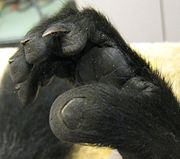
Toilet-claw
Encyclopedia

Claw
A claw is a curved, pointed appendage, found at the end of a toe or finger in most mammals, birds, and some reptiles. However, the word "claw" is also often used in reference to an invertebrate. Somewhat similar fine hooked structures are found in arthropods such as beetles and spiders, at the end...
or nail
Nail (anatomy)
A nail is a horn-like envelope covering the dorsal aspect of the terminal phalanges of fingers and toes in humans, most non-human primates, and a few other mammals. Nails are similar to claws, which are found on numerous other animals....
on the foot of certain primate
Primate
A primate is a mammal of the order Primates , which contains prosimians and simians. Primates arose from ancestors that lived in the trees of tropical forests; many primate characteristics represent adaptations to life in this challenging three-dimensional environment...
s, used for personal grooming
Personal grooming
Personal grooming is the art of cleaning, grooming, and maintaining parts of the body. It is a species-typical behavior that is controlled by neural circuits in the brain.- In humans :...
. All prosimian
Prosimian
Prosimians are a grouping of mammals defined as being primates, but not monkeys or apes. They include, among others, lemurs, bushbabies, and tarsiers. They are considered to have characteristics that are more primitive than those of monkeys and apes. Prosimians are the only primates native to...
s have a toilet claw, but the digit that is specialized in this manner varies. Tarsier
Tarsier
Tarsiers are haplorrhine primates of the genus Tarsius, a genus in the family Tarsiidae, which is itself the lone extant family within the infraorder Tarsiiformes...
s have a toilet claw on toe
Toe
Toes are the digits of the foot of a tetrapod. Animal species such as cats that walk on their toes are described as being digitigrade. Humans, and other animals that walk on the soles of their feet, are described as being plantigrade; unguligrade animals are those that walk on hooves at the tips of...
two and toe three. With one possible exception, in the suborder Strepsirrhini
Strepsirrhini
The clade Strepsirrhini is one of the two suborders of primates. Madagascar's only non-human primates are strepsirrhines, and others can be found in southeast Asia and Africa...
, which includes lemur
Lemur
Lemurs are a clade of strepsirrhine primates endemic to the island of Madagascar. They are named after the lemures of Roman mythology due to the ghostly vocalizations, reflective eyes, and the nocturnal habits of some species...
s, galago
Galago
Galagos , also known as bushbabies, bush babies or nagapies , are small, nocturnal primates native to continental Africa, and make up the family Galagidae...
s and lorises
Lorisidae
Lorisidae is a family of strepsirrhine primates. The lorisids are all slim arboreal animals and include the lorises, pottos and angwantibos. Lorisids live in tropical, central Africa as well as in south and southeast Asia....
, the toilet claw is on the second toe. The possible exception is the aye-aye
Aye-aye
The aye-aye is a lemur, a strepsirrhine primate native to Madagascar that combines rodent-like teeth and a special thin middle finger to fill the same ecological niche as a woodpecker...
, which has claws instead of nails on toes 2 through 5. There is some debate concerning whether any of these claws (and if so which ones) are toilet claws.
The first toe is the large one, the equivalent of a human big toe
Hallux
In tetrapods, the hallux is the innermost toe of the foot. Despite its name it may not be the longest toe on the foot of some individuals...
. However, in all these prosimians the foot is more or less hand-like. The first toe is opposable, like a human thumb
Thumb
The thumb is the first digit of the hand. When a person is standing in the medical anatomical position , the thumb is the lateral-most digit...
, and the second and third toes correspond approximately to the index and middle fingers.
Like a claw
Claw
A claw is a curved, pointed appendage, found at the end of a toe or finger in most mammals, birds, and some reptiles. However, the word "claw" is also often used in reference to an invertebrate. Somewhat similar fine hooked structures are found in arthropods such as beetles and spiders, at the end...
or a nail
Nail (anatomy)
A nail is a horn-like envelope covering the dorsal aspect of the terminal phalanges of fingers and toes in humans, most non-human primates, and a few other mammals. Nails are similar to claws, which are found on numerous other animals....
, the toilet-claw is also made of keratin
Keratin
Keratin refers to a family of fibrous structural proteins. Keratin is the key of structural material making up the outer layer of human skin. It is also the key structural component of hair and nails...
. It resembles a claw in both its lateral compression and longitudinal curvature. However, the tip is not as pointed, and it always stands at a steeper angle, a characteristic that also distinguishes it from a nail.
Etymology
The term for this prosimian anatomical structure comes from its function, which is to assist in grooming or toilet functions. The term toilet, as used in American English, has changed over the past century. Historically, it was used to refer to personal grooming, not a lavatory device. Due to changes in the perception of the term, some sources have started to use the term grooming claw instead. However, the scientific literature still strongly favors the original term.Function
The toilet-claw is used in personal grooming to rake through the fur, particularly where an individual cannot reach with its mouth and toothcombToothcomb
A toothcomb is an anatomical structure found in strepsirrhine primates, which includes lemurs, lorises and galagos. A toothcomb consists of long, flat forward-angled teeth, and includes the lower incisors and the canine teeth...
.

